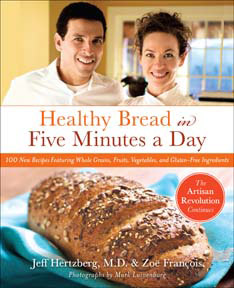Artisan Bread in Five
No-knead bread on your schedule
As a practical guide to incorporating No-Knead Bread baking into daily life, regardless of your schedule, I highly recommend Artisan Bread in Five Minutes a Day and the follow-up Healthy Bread in Five Minutes a Day. I’ve been baking from the instructions in these books for some time now, and I hardly ever buy commercial bread. My young ones love the bread, especially warm from the oven, and there’s something special about bringing your own fresh baked bread to a get-together.
Why Artisan Bread in Five Minutes a Day? Literally five minutes of effort. Throw the ingredients together, mix, pop the dough into a bucket and then into the fridge. After a couple hours of rising, I have enough for three big loaves. The dough keeps very well in the refrigerator for a couple weeks (and tastes noticeably better the longer it’s been sitting, though mine rarely makes it that long). When I want fresh bread I pull out a bit of dough, get the oven heated up and bake away. There are plenty of no-knead recipes about, but Jeff Hertzberg and Zoe Francois perfected a process that works for me.

The main advantage I’ve gotten out of Healthy Bread in Five Minutes a Day is feeding the kids a bit more whole grain and some protein as well. I find the flavor richer, too (beer helps that a bunch, but also subtracts a few healthy points). I do prefer the texture of the white loaf, and for guests or as a host gift, I’d likely choose the original recipe. Of late, our everyday breadbox loaf comes from the Healthy book. Slices, toasted a bit, make a heavenly sandwich.
02/2/10Excerpt
From Healthy Bread in Five Minutes a Day:
Whole grain flour is better for you than white flour. Because whole grains include the germ and the bran, in addition to the starch-rich but fiber- and vitamin-poor endosprem....whole grain flours bring a boatload of healthy substances into your diet, including phytochemicals....,vitamins, and fiber. Those are pretty much absent from white flour. Iron, niacin, folic acid, riboflavin, and thiamine are added back in enriched commercial white flour, but no other nutrients—so whole wheat delivers more complete nutrition than white flour even when it's been enriched. But there's more—because bran and germ in whole grains dilute the effect of pure starch in the endosprem, the absorption and conversion of starches into simple sugars is slowed, so blood glucose...rises more slowly after consumption of whole grains than it does after eating refined white flour products.
*
Our first book concentrated on ingredients from the traditional European baker's cupboard. We've updated our discussion to include whole grains, vital wheat gluten, and even ingredients for gluten-free breads. Perhaps the most crucial ingredient to get familiar with is vital wheat gluten. It's essential for achieving a light loaf when using lots of whole grains, never kneading, and still storing the dough in the refrigerator.
*
Yeast Love to Keep Cool
Jefferson University yeast biochemist Hannah Silver, Ph.D., loves great bread, and bakes her own with our method. We asked her where the great flavor comes from, especially with dough that has aged a few days: "Yeast extracts are sometimes used as a flavor enhancer in commercial food, and they introduce a savory, complex flavor, sometimes called umami, the so-called fifth basic taste recognized by the human tongue (in addition to sweet, salty, bitter, and sour). The flavor you get with stored dough comes from chemicals produced by yeast as they use sugars and starches to make carbon dioxide gas (which forms bubbles to leaven the bread) and alcohol (which boils off in baking).
(Thanks to readers Drew Mills and Bob Mintiero for also recommending Artisan Bread -es — editors)






